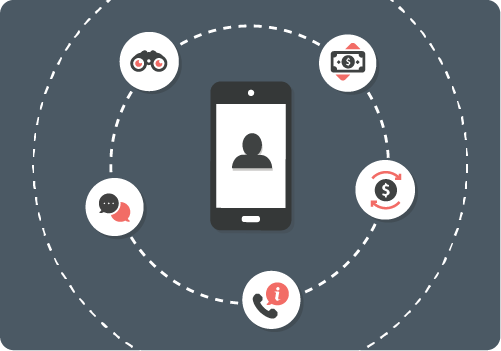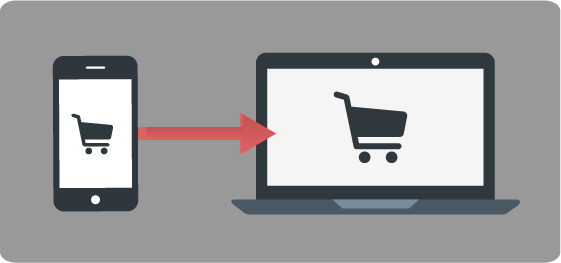Formulate Your Vision
Learning Objectives
- Explain how contextual research can help you identify micro-moments.
- Define the concept of sequential usage.
- Conduct the types of research that will reveal mobile opportunities.
- Identify and prioritize ideas for mobile apps and services.
Remember Your Users
So now you have business goals for your mobile strategy. But your mobile vision is incomplete because your organization’s objectives are only half the story. What about your users? What are their goals? In this unit, we address the next component of mobile strategy: user value.
As you learned earlier, micro-moments are the key to unlocking the potential of mobile. To provide value to mobile users, you must anticipate those moments and deliver solutions that are immediate, useful, and contextual. So how do you anticipate micro-moments? Do you use a crystal ball? Maybe develop your mind-reading skills?
- Do you know how customers discover your products and services?
- What makes them decide to buy, and what’s the purchasing process like?
- What factors influence their decision to stay with your company? To buy again?
- How do they seek help?
- How do they engage with your brand?

At every stage in their life cycle, your customer can potentially reach for their phone. At what points are they most likely to do that, and what are they trying to accomplish? You can’t identify the right mobile solutions until you truly understand your user’s context, behaviors, and intent—each step of the way.
Your Users Have Multiple Devices
Here’s a complicating factor. In its study called “The New Multi-Screen World,” Google found that we split our time between all of our beloved devices—phone, tablet, computer, and television. According to the study:
- 90% of consumers jump from one screen to another during the day.
- 90% of users move between devices to accomplish a single goal.
- The device we choose to use at a particular time is driven by context.
So a user can begin an activity on their phone, but finish the same activity on a laptop. This is called sequential usage, and it highlights why it’s important to uncover contextual information.

For example, maybe your customers tend to make purchases at your retail locations, but they start the shopping process by browsing and researching on their phone. How does that affect your mobile strategy? If you’re missing critical data about your user’s context and intent, you can’t deliver the optimal mobile solution.
Do the Right Research
When it comes to gathering contextual data, not all research methods are created equal. Many companies prioritize quantitative research, like surveys and web analytics. Quantitative research is about numbers and trends, and it’s useful to a certain degree. But it falls short when you want to learn details about your user’s needs and intentions in specific contexts.
- Ethnographic studies: The two most common types of ethnographic studies are interviews and observation. Both are helpful for getting to know your users and discovering details about their goals and behaviors in specific contexts. To learn more about these methods, take the UX Research Basics module.
- Customer journey mapping: A journey map is a diagram that illustrates the steps your customers take when engaging with your company. Generally journey maps are “cradle to grave”—they track all the touch points of each stage in the customer’s journey so you get a holistic view of their life cycle. Check out the links in the resource section for examples and guidance.
Find Mobile Opportunities
After you’ve defined your business objectives and done some user research, you’re ready for the next step: identifying mobile opportunities. This is where the real magic happens.
With your business goals in mind, analyze the results of your contextual research. What are your user’s goals? How can mobile fit into the user life cycle? As you go through this process, you’ll find areas where your user’s mobile needs overlap with your organization’s mobile objectives.

Eureka! You found your mobile opportunities. Want some examples? These can help you understand the process of merging your goals with your users’ goals:
| Audience | Objective | Related User Experience | Mobile Opportunity |
|---|---|---|---|
| Customers of an apartment management company | Increase customer retention rates | Tenants are frustrated by a complicated and outdated maintenance request system | A mobile app that lets tenants easily create and track service requests |
| Customers of a major retailer | Increase customer loyalty | Customers don’t want to carry around reward cards or miss out on various sales promotions | A loyalty mobile app that keeps track of customer purchases and rewards, and pushes location- and time-based promotions |
| Employees | Increase employee productivity | Employees can’t submit timely approvals, which results in processing delays | An approvals mobile app that lets employees submit and approve requests on the go |
| Employees | Increase employee satisfaction | Employees can’t easily collaborate with their colleagues or get answers to questions | A mobile app that enables employees to collaborate, exchange ideas, and network |
Prioritize Your Mobile Ideas
Once you start coming up with ideas for mobile solutions, you’ll see opportunities everywhere. Apps for employees! Apps for customers! Apps for partners!
Hold your horses, buckaroo. You can’t develop all those projects at once. Start small. Be selective. When you’re trying to decide which mobile solutions deliver the most significant results, consider:
- Business value
- Your organization’s mobile maturity
- Market opportunity
- Ease of implementation
- Security requirements
- Speed to market
- Availability of resources
- Ease of user adoption
- Global requirements
Weigh each mobile idea against those factors, prioritize them, and create a backlog of projects. Then the vision becomes clear: Your mobile journey starts with the first idea on your backlog. Boom! One step closer to mobile world domination.

OK, now that you’ve crafted the vision for your mobile strategy, it’s time to figure out a way to execute it. So let’s look at what it takes to build a mobile app from scratch. In the next unit, you learn how your organization can create a plan that accounts for the various tools, technologies, resources, and processes necessary to design and develop mobile projects.